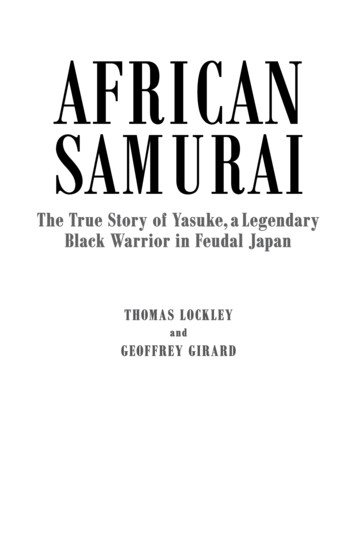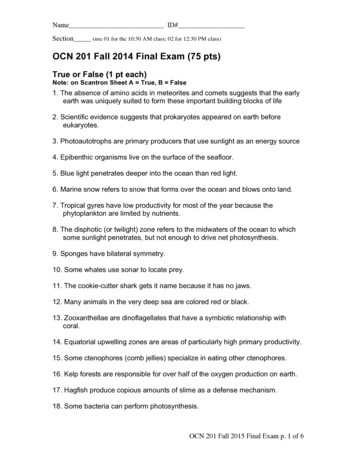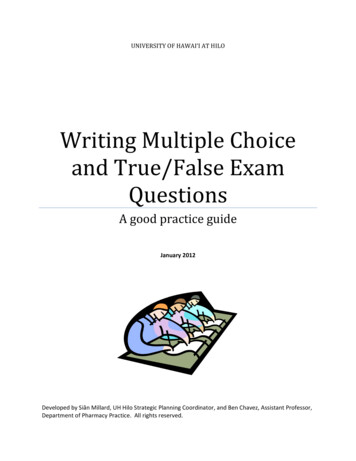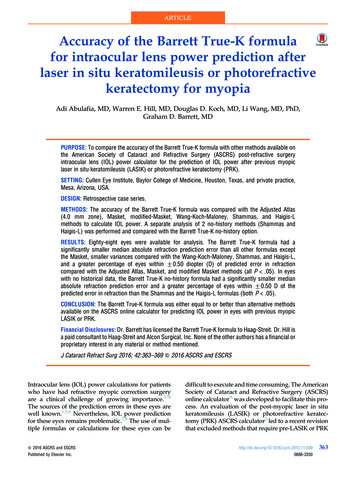
Transcription
The True Story of Yasuke, a LegendaryBlack Warrior in Feudal JapanTHOMAS LOCKLEYandGEOFFREY GIRARD
African SamuraiCopyright 2019 by Thomas LockleyPublished by arrangement with Tuttle-Mori Agency, Inc., Tokyo, in association withFoundry Literary Media, New York.All rights reserved. Except for use in any review, the reproduction or utilization of this workin whole or in part in any form by any electronic, mechanical or other means, now known orhereafter invented, including xerography, photocopying and recording, or in any informationstorage or retrieval system, is forbidden without the written permission of the publisher,Hanover Square Press, 22 Adelaide Street West, 40th Floor, Toronto, Ontario M5H 4E3, Canada. and TM are trademarks of Harlequin Enterprises Limited or its corporate affiliates. Trademarksindicated with are registered in the United States Patent and Trademark Office, the CanadianIntellectual Property Office and in other countries.Library of Congress Cataloging-in-Publication Data has been applied for.HanoverSqPress.comBookClubbish.comPrinted in U.S.A.
AFTERWORDThe WitnessesLuís Fróis: Fróis, the most prolific writer on Yasuke, was bornin Lisbon in 1532 and joined the Jesuits in 1548. He arrived inJapan in 1563. Fróis wrote more than one hundred letters andreports about Japan, many running to thousands of words, andseveral books during the 1580s and ’90s. His work, which ishighly observant, descriptive and even entertaining, formedmuch of the basis of European knowledge on Japan until themodern age and he was one of the greats of the Jesuit missionin Japan. He was remembered by a colleague as: “meritoriousmore than any others of the Japanese Christianism and for thedeeds which during thirty-four years consumed him there, andfor the memories of the successes of that Church of which heyearly gave news to Europe.” He lived the last seven years ofhis life in Nagasaki where he died in 1597, aged sixty-five. His1
last published work was an eye-witness report of the Nagasakimartyrs’ executions of 1597.Ōta Gyuˉ ichi: The author of The Chronicle of Oda Nobunaga,and numerous other books recording the times in which helived, was born in 1527 and died in 1613. As a samurai he wasan expert archer who took part in many of Nobunaga’s earlybattles. He was also a member of Nobunaga’s falconry team.By the 1570s, he had been promoted to Nobunaga’s administrative staff in both Kyoto and Azuchi. He proceeded to serveHideyoshi and then his son in administrative capacities. Mostof his writing was only published posthumously from manuscripts and diaries he wrote throughout his life. He recordedYasuke twice, specifically covering his first audience and thefact of his promotion.Matsudaira Ietada: Matsudaira Ietada, 1555–1600, who recorded Yasuke once in his diary after the Takeda campaign,went on to be promoted under his kinsman Tokugawa Ieyasu.In 1599, he was given command of Fushimi Castle near Kyoto.It proved a fatal appointment. In 1600, just prior to the decisive Battle of Sekigahara at which Tokugawa seized the reins ofpower for good, Matsudaira died defending the walls. His diaryis one of the best historical sources of the times he lived in.Lourenço Mexia: Mexia was a close aide to Valignano and alsoan informant on his activities to Rome, appointed by the JesuitSuperior General himself. He was a strong supporter of Valignano’s policy of adaptation to Japanese norms, especially regardingdiet. He observed that the Japanese judged people on what theyate and how they ate it, and the European’s table manners anddietary choices, especially meat, were damaging their likelihoodof converting the Japanese. He must have known Yasuke well,but chose to record his presence only once due to his surpris2
ingly swift promotion in Nobunaga’s service (this is one moremention than Valignano saw fit to include). It is from Mexia thatwe know about Yasuke and Nobunaga’s close conversations andpotential elevation to lord status. He died in 1599.The JesuitsAlessandro Valignano: Alessandro Valignano left Japan in1582 bound for Europe with the first Japanese embassy to Rome,but he never got there. In India, new orders awaited him, appointing him to the post of Provincial of the Jesuits in Asia. Hereturned to Japan twice, in 1590–1592 and 1598–1603, but wasbased mainly in Macao where he carried on his educationaltradition by, among other things, founding St. Paul’s Collegeof Macao (which claims to be the first European university inAsia) to train Jesuits in Chinese language and traditions to facilitate their mission there.Valignano was said to be a man of “tremendous energy andboundless religious ardor, a born leader of men, who by thecharm of his personality and the irresistible power of his example inspired the missionaries with ever‑fresher and ever-greaterenthusiasm for their work.” This energy allowed him to writeperhaps dozens of books and thousands of letters about the FarEast, the best methods of missionary work and instruction manuals on how to logically refute “paganism” and numerous educational tracts. It is said he often worked into the early hoursof the morning.The Japanese embassy which he sent to Rome in the 1580s,normally referred to as the Tensho Embassy, met with two Popesand wowed both European rulers and their citizens. Their visitwas quite the event of the decade, with crowds of thousandsturning out to greet them. Even Queen Elizabeth of England,persona non grata in Catholic lands after her excommunicationin 1570, demanded two reports a week from her European spies3
on their progress. The leader, Ito Mancio, was appointed Cavaliere di Speron d’Oro (Knight of the Order of the Golden Spur),and is possibly the only samurai to have concurrently been aEuropean knight also.After Valignano’s death, an anonymous colleague wrote, “Inhim we lament not only our former Visitor and Father, but, asmany will have it, the Apostle of Japan. For, filled with a special love for that Mission and burning with zeal for the conversion of that realm, he set no limit to his efforts on behalf of it.”Valignano died in Macao in 1606, at the age of sixty-seven.There is no record of him having met Yasuke again.Today, less than 1 percent of the Japanese population is Christian.Father Gnecchi Soldo Organtino: After the destruction ofAzuchi, including the seminary, Organtino was resident in thesafety of Lord Takayama Ukon’s Takatsuki fief until he managedto found a new mission in Osaka. Kyoto was still too volatile anduncertain. He tried to mitigate the fallout from Hideyoshi’s banning of the Jesuits in 1587, but ultimately failed. However, he managed to stay in hiding within the proximity of Kyoto to support theChristian community there, and even baptized two of Nobunaga’sgrandsons. He died in 1609, in Nagasaki, at the age of seventy-six.Father Gaspar Coelho: The mission superior who caused somuch trouble by his scheming and overly aggressive attitude didnot live long enough to be chastised by Valignano on his secondvisit. He died in disgrace in 1590 at Kazusa, near Kuchinotsu,where Yasuke had brief ly lived ten years before and Valignanohad set up his first seminary.The WarlordsHideyoshi: Hideyoshi came out on top in the brief battle tosucceed Nobunaga and continued his work of unifying Japan.4
He initially supported the Catholic missionaries in their work,but like Nobunaga had no serious religious conviction, unless itsuited his political ends. The Jesuits eventually got on his nerves,and seeing them as a potential threat, like every other potentialthreat, he dealt with them. In 1587, he banished all Jesuits fromhis realm. He never seriously enforced the prescript, but it wasthe first warning sign that Catholicism would not have an easyfuture in Japan. By the early 1590s, there was nothing left to doin the unification of Japan, and Hideyoshi decided to invadeKorea with the ultimate goal being to sit on the imperial throneof China and possibly conquer India as well. Although the warwas clearly a failure, Hideyoshi refused to concede defeat and theworn-out samurai held on in isolated castles on the Korean coastuntil he died. This legacy strains East Asian relations to this day.Tokugawa Ieyasu: Nobunaga’s key ally. Following Hideyoshi’sdeath, Tokugawa Ieyasu usurped power through acting as chief regent for Hideyoshi’s infant son Hideyori (a similar ploy Hideyoshihad used when assuming Nobunaga’s power). Tokugawa’s ascent,however, was not without dissent, and resulted in a series of battles.The final conflict was one of the largest battles, globally, of thewhole seventeenth century. The Battle of Sekigahara, in which approximately one hundred seventy thousand warriors took part (onthe day itself; tens of thousands of others were delayed or fightingon related battlefields), was a decisive victory and decided Japanese politics for nearly three hundred years. Tokugawa’s ancestorswould rule in peace, with virtually no challenge, until the 1860s.Ieyasu himself, described as one of the richest men in the worldby an English merchant, founded Tokyo and left a legacy of lawsand guidance that shapes Japanese society to this day. He is considered by some to be one of the greatest statesmen who ever lived.Takayama Ukon: Takayama’s support was crucial for Hideyoshi’s usurpation of the national leadership of the Oda clan, but5
that did not mean he was invulnerable. In 1587, Hideyoshi ordered all Christian lords to renounce their faith. Takayama declined and was banished. He received a measure of forgivenessthrough being permitted to enter the service of the powerfulMaeda clan but still refused to renounce Catholicism. After thedefinitive and final Jesuit expulsion edict in 1614, which included prominent Japanese Christians, he went into foreign exile,along with three hundred of his followers, in Manila. The colonial government of the Spanish Philippines saw an opportunityand offered to invade Japan to protect the Japanese Christians.Takayama refused to give his support and shortly afterward,in February 1615, breathed his last. The Spanish honored himwith the funeral of a great lord and he is commemorated with astatue in the center of the old Japanese quarter of Manila, PlazaDilao. With the support of Pope Francis in Rome, Takayamawas beatified in his home town of Osaka in 2017, and becamethe Blessed Justo Takayama Ukon, only one step from sainthood.Arima Harunobu: Arima Harunobu, who’d first welcomedYasuke to Japan, regained some measure of autonomy after theBattle of Okitanawate, but remained in the shadow of his Sa tsuma clan allies. His people knew peace for the first time in decades. When the Shimazu were humbled by Hideyoshi, Arimabent the knee to him and subsequently was dispatched with twothousand troops to Korea in 1592. His run of picking the victorscontinued when he supported Tokugawa Ieyasu after Hideyoshi’sdeath but his luck ran out when he failed in a mission to invadeTaiwan and some sailors on one of his ships ran amok in Macaoand were executed by the Portuguese authorities in 1608. Thefollowing year, he seized the Portuguese trading ship in Nagasaki in revenge and after a long battle, Captain Major AndréPessoa blew up the whole ship rather than surrender. AlthoughIeyasu rewarded Arima for this, the “reward” was a marriage6
between Arima’s son and Ieyasu’s adoptive daughter, a problembecause Arima’s son was already married. The son capitulatedand divorced his Catholic wife, apostatized and poisoned Ieyasu’s mind against his own father, and in 1612, the senior Arima,already exiled, was ordered to perform seppuku. As a Christian, Arima could not commit suicide, so instead he acceptedthe death of a common criminal, beheading.Katō Kiyomasa: The warlord who employed “Kurobo,” andwrought havoc in Korea. After Hideyoshi’s death, Katoˉ choseto support Tokugawa Ieyasu, and was rewarded richly by becoming one of the most powerful lords in the land. He alsoremained loyal, however, to Hideyoshi’s son Hideyori, whomIeyasu had usurped, and attempted to act as a mediator betweenthem. He died in 1611.Ōtomo Sōrin: Ōtomo Sōrin became a vassal of the great conqueror, Hideyoshi, in 1587. He died of old age the same year.We know nothing more of his estranged wife “Jezebel,” exceptthat she also died in 1587.Ōmura Sumitada: The lord who gifted the Jesuits Nagasaki.Despite Ōmura’s questionable adherence to Catholicism at first(to obtain arms and outside support), he made strenuous effortsto understand the creed and remained a Christian until his deathfrom tuberculosis, on June 23, 1587. There is no record of whathappened to his daughter, who’d refused to marry Arima. Hisson Yoshiaki, however, made the politically astute move (in theclimate of the early seventeenth century) to ban the Jesuits andChristianity from the Ōmura domain.Hattori Hanzō: Nobunaga destroyed the autonomy of the Iganinja once and for all. However, their leader, Hattori Hanzō,took them into the service of Tokugawa Ieyasu, and a large7
corps, around three hundred, formed a part of the guard atIeyasu’s new Edo Castle. Hattori has gone down in history andlegend as the best known of the ninja, and as such has enjoyeda huge showing in popular culture, video games, movies, television, manga and books in Japan and overseas. Most famouslythe Kage no Gundan (Shadow Warriors) movie and TV serieswhich depict him and his (semifictional) descendants. Hattoriand his descendants of each generation, also named Hanzō, wereplayed by Sonny Chiba in the series, and when Quentin Tarantino needed a Hattori Hanzō for the movie Kill Bill, he commissioned Chiba to play a fictional Hattori Hanzō XIV. The gatethat Hattori guarded in Edo Castle, now the Imperial Palace,was named after him, and in turn the Hanzōmon metro line, isnamed after the castle gate.The PlacesJapan: Japan was reunified as a political unit by Hideyoshi in1590 bringing an uneasy end to The Age of the Country at War.It turn
following year, he seized the Portuguese trading ship in Na-gasaki in revenge and after a long battle, Captain Major André Pessoa blew up the whole ship rather than surrender. Although Ieyasu rewarded Arima for this, the “reward” was a marriage 6











